Timothy Ferriss's Blog, page 116
August 12, 2012
Understanding the Dangers of “Ego-Depletion”

(Image: Someecards)
This is a guest post by Dan Ariely, James B Duke Professor of Psychology and Behavioral Economics at Duke University.
I’ve always suspected that we start each day with a limited number of decision-making points that, once depleted, leave us cognitively impaired. This is part of the reason that automating minutiae, adopting rituals, and applying creativity only where it’s most valuable (e.g. not deciding what to eat for breakfast) is so important to me.
I just don’t have the bandwidth to get big things done by doing otherwise. Perhaps, just as Phelps was born with bigger lungs than 99.9% of the population, and just as some people only need four hours of sleep per night, some people are born with more decision-making “hit points” than others?
Food for thought. This leads to Dan’s discussion of “ego-depletion” and how to insure against making bad decisions…
Enter Dan
From your own experience, are you more likely to finish half a pizza by yourself on a) Friday night after a long work week or b) Sunday evening after a restful weekend? The answer that most people will give, of course, is “a”. And in case you hadn’t noticed, it’s on stressful days that many of us give in to temptation and choose unhealthy options. The connection between exhaustion and the consumption of junk food is not just a figment of your imagination.
And it is the reason why so many diets bite it in the midst of stressful situations, and why many resolutions derail in times of crisis.
How do we avoid breaking under stress? There are six simple rules.
1) Acknowledge the tension, don’t ignore it.
Usually in these situations, there’s an internal dialogue (albeit one of varying length) that goes something like this:
“I’m starving! I should go home and make a salad and finish off that leftover grilled chicken.”
“But it’s been such a long day. I don’t feel like cooking.” [Walks by popular spot for Chinese takeout] “Plus, beef lo mein sounds amazing right now.”
“Yes, yes it does, but you really need to finish those vegetables before they go bad, plus, they’ll be good with some dijon vinaigrette!”
“Not as good as those delicious noodles with all that tender beef.”
“Hello, remember the no carbs resolution? And the eat vegetables every day one, too? You’ve been doing so well!”
“Exactly, I’ve been so good! I can have this one treat…”
And so the battle is lost. This is the push-pull relationship between reason (eat well!) and impulse (eat that right now!). And here’s the reason we make bad decisions: we use our self-control every time we force ourselves to make the good, reasonable decision, and that self-control, like other human capacities, is limited.
2) Call it what it is: ego-depletion.
Eventually, when we’ve said “no” to enough yummy food, drinks, potential purchases, and forced ourselves to do enough unwanted chores, we find ourselves in a state called ego-depletion, where we don’t have any more energy to make good decisions. So–back to our earlier question–when you contemplate your Friday versus Sunday night selves, which one is more depleted? Obviously, the former.
You may call this condition by other names (stressed, exhausted, worn out, etc.) but depletion is the psychological sum of these feelings, of all the decisions you made that led to that moment. The decision to get up early instead of sleeping in, the decision to skip pastries every day on the way to work, the decision to stay at the office late to finish a project instead of leaving it for the next day (even though the boss was gone!), the decision not to skip the gym on the way home, and so on, and so forth. Because when you think about it, you’re not actually too tired to choose something healthy for dinner (after all, you can just as easily order soup and sautéed greens instead of beef lo mein and an order of fried gyoza), you’re simply out of will power to make that decision.
3) Understand ego-depletion.
Enter Baba Shiv (a professor at Stanford University) and Sasha Fedorikhin (a professor at Indiana University) who examined the idea that people yield to temptation more readily when the part of the brain responsible for deliberative thinking has its figurative hands full.
In this seminal experiment, a group of participants gathered in a room and were told that they would be given a number to remember, and which they were to repeat to another experimenter in a room down the hall. Easy enough, right? Well, the ease of the task actually depended on which of the two experimental groups you were in. You see, people in group 1 were given a two-digit number to remember. Let’s say, for the sake of illustration, that the number is 62. People in group two, however, were given a seven-digit number to remember, 3074581. Got that memorized? Okay!
Now here’s the twist: half way to the second room, a young lady was waiting by a table upon which sat a bowl of colorful fresh fruit and slices of fudgy chocolate cake. She asked each participant to choose which snack they would like after completing their task in the next room, and gave them a small ticket corresponding to their choice. As Baba and Sasha suspected, people laboring under the strain of remembering 3074581 chose chocolate cake far more often than those who had only 62 to recall. As it turned out, those managing greater cognitive strain were less able to overturn their instinctive desires.

(Photo: PetitPlat)
This simple experiment doesn’t really show how ego-depletion works, but it does demonstrate that even a simple cognitive load can alter decisions that could potentially have an effect on our lives and health. So consider how much greater the impact of days and days of difficult decisions and greater cognitive loads would be.
4) Include and consider the moral implications.
Depletion doesn’t only affect our ability to make good decisions, it also makes it harder for us to make honest ones. In one experiment that tested the relationship between depletion and honesty, my colleagues and I split participants into two groups, and had them complete something called a Stroop task, which is a simple task requiring only that the participant name aloud the color of the ink a word (which is itself a color) is written in. The task, however, has two forms: in the first, the color of the ink matches the word, called the “congruent” condition, in the second, the color of the ink differs from the word, called the “incongruent” condition. Go ahead and try both tasks yourself…
The congruent condition: color matches word.

The incongruent condition: color conflicts with word.
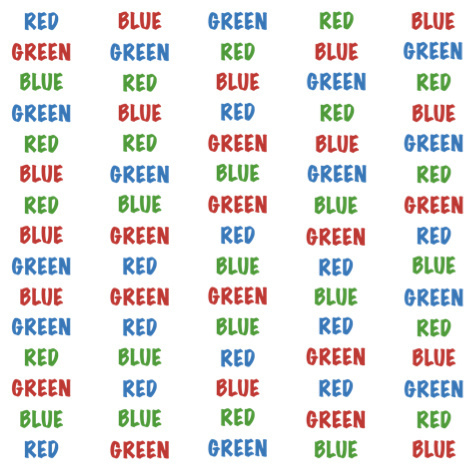
As you no doubt observed, naming the color in the incongruent version is far more difficult than in the congruent. Each time you repressed the word that popped instantly into your mind (the word itself) and forced yourself to name the color of the ink instead, you became slightly more depleted as a result of that repression.
As for the participants in our experiment, this was only the beginning. After they finished whichever task they were assigned to, we first offered them the opportunity to cheat. Participants were asked to take a short quiz on the history of Florida State University (where the experiment took place), for which they would be paid for the number of correct answers. They were asked to circle their answers on a sheet of paper, then transfer those answers to a bubble sheet. However, when participants sat down with the experimenter, they discovered she had run into a problem. “I’m sorry,” the experimenter would say with exasperation, “I’m almost out of bubble sheets! I only have one unmarked one left, and one that has the answers already marked.” She explained to participants that she did her best to erase the marks but that they’re still slightly visible. Annoyed with herself, she admits that she had hoped to give one more test today after that one, then asks a question: “Since you are the first of the last two participants of the day, you can choose which form you would like to use: the clean one or the premarked one.”
So what do you think participants did? Did they reason with themselves that they’d help the experimenter out and take the premarked sheet, and be fastidious about recording their accidents accurately? Or did they realize that this would tempt them to cheat, and leave the premarked sheet alone? Well, the answer largely depended on which Stroop task they had done: those who had struggled through the incongruent version chose the premarked sheet far more often than the unmarked. What this means is that depletion can cause us to put ourselves into compromising positions in the first place.
And what about the people, in either condition, who chose the premarked sheet? Once again, those who were depleted by the first task, once in a position to cheat, did so far more often than those who breezed through the congruent version of the task.
What this means is that when we become depleted, we’re not only more apt to make bad and/or dishonest choices, we’re also more likely to allow ourselves to be tempted to make them in the first place. Talk about double jeopardy.
5) Evade ego-depletion.
There’s a saying that nothing good happens after midnight, and arguably, depletion is behind this bit of folk wisdom. Unless you work the third shift, if you’re up after midnight it’s probably been a pretty long day for you, and at that point, you’re more likely to make sub-optimal decisions, as we’ve learned.
So how can we escape depletion?
A friend of mine named Dan Silverman once suggested an interesting approach during our time together at the Institute for Advanced Study at Princeton, which is a delightful place for researchers to take a year off to think, plan, and eat very well. Every day, after a rich lunch, we were plied with nigh-irresistible desserts: cheesecake, chocolate tortes, profiteroles, beignets—you name it. It was difficult for all of us, but especially for poor Dan, who was forever at the mercy of his sweet tooth.
It was daily dilemma for my friend. Dan, who was an economist with high cholesterol, wanted dessert. But he also understood that eating dessert every day was not a good decision. He contemplated this problem (along with his other academic interests), and concluded that when faced with temptation, a wise person should occasionally succumb. After all, by doing so, said person can keep him- or herself from becoming overly depleted, which will provide strength for whatever unexpected temptations lie in wait. Dan decided that giving in to daily dessert would be his best defense against being caught unawares by temptation and weakness down the road.
In all seriousness though, we’ve all heard time and time again that if you restrict your diet too much, you’ll likely to go overboard and binge at some point. Well, it’s true. A crucial aspect of managing depletion and making good decisions is having ways to release stress and reset, and to plan for certain indulgences. In fact, I think one reason the Slow-Carb Diet seems to be so effective is because it advises dieters to take a day off (also called a “cheat” day–see item 4 above), which allows them to avoid becoming so deprived that they give up entirely. The key here is planning the indulgence rather than waiting until you have absolutely nothing left in the tank. It’s in the latter moments of desperation that you throw yourself on the couch with the whole pint of ice cream, not even making a pretense of portion control, and go to town while watching your favorite tv show.
Regardless of the indulgence, whether it’s a new pair of shoes, some “me time” where you turn off your phone, an ice cream sundae, or a night out—plan it ahead. While I don’t recommend daily dessert, this kind of release might help you face down challenges to your will power later.
6) Know Thyself.

(Image: AnEpicDay)
The reality of modern life is that we can’t always avoid depletion. But that doesn’t mean we’re helpless against it. Many people probably remember the G.I. Joe cartoon catch phrase: “Knowing is half the battle.” While this served in the context of PSAs of various stripes, it can help us here as well. Simply knowing you can become depleted, and moreover, knowing the kinds of decisions you might make as a result, makes you far better equipped to handle difficult situations when and as they arise.
About the author: Dan Ariely is also the author of several excellent books, including Predictably Irrational and, most recently, The Honest Truth About Dishonesty.






August 6, 2012
The 4-Hour Chef Media – Announcement
Hi All,
This is more of an announcement than a post. There’s a fun video on writing and book marketing coming next, but first…
ATTENTION MEDIA, BLOGGERS, AND LIST OWNERS
I’ve made very few media commitments thus far related to The 4-Hour Chef and its launch November 20th.
It’s going to be bigger and badder than my last two books.
Do you have a magazine, column, blog, TV show, radio show, or mailing list? Would you like to do an interview, feature, or post an excerpt from the book? Please click here to let me know. I have a ton of material, including experiments, video, pictures, case studies, etc.
Hope to hear from you!
This is the book I’ve always wanted to write. It’s going to be a hell of a ride.






August 3, 2012
The 4-Hour Chef 8-Second Book Trailer — Finals
Wow. The audio submissions for the 8-second book trailer are simply AMAZING. I listened to hundreds of the almost 800 entries. So sorry for the delay in things, but I wanted to hear as many as possible. Thank you all so much for submitting!
Please help me vote for the winner with the below video form (deadline 5pm PT August 10)! To watch the video sync’ed to the music, just play the track and scroll back up to watch the video.
Here are the six finalists I picked. The winner gets $2,000!






July 26, 2012
How I Blog — The 21 WordPress Plugins That Keep Me Sane

So, you want a high-traffic blog… (Photo: Bill Gracey)
The following post can be considered Part II in a series on how I blog. Part I, which covers mostly everything not below, is titled “How to Build a High-Traffic Blog Without Killing Yourself.”
Beginning at the Beginning
My very first blog post of all time was December 31, 2006 (scroll down here). One comment! Ah, success…
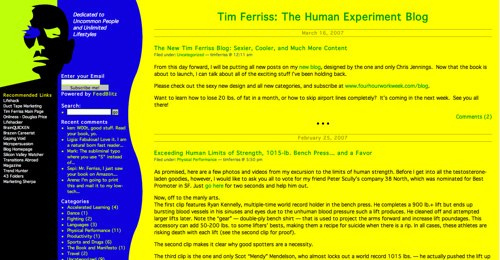
Who the hell designed that atrocity? Oh, it was me…
For many months, I “blogged” by imitation, putting out a lot of boring stuff. I felt, and still feel, that this imitate-before-you-create phase was critical to finding my own voice. But, as one then DoubleClick manager put it to me over wine, after reviewing my posts:
“A mediocre blog is more of a liability than no blog at all.”
Taking this to heart, I upgraded, both in terms of design and writing. I started publishing more original long-form content and organizing around a few central themes. I invested $1,500 and launched the blog you now see. Well, it was close:

The very first post was March 7, 2007. It scored six comments (a 500% increase!)… and I was ecstatic.
This work was done in preparation for April 27, 2007, the launch date for The 4-Hour Workweek. I viewed the blog primarily as a marketing tool. This changed when lightning struck with “How to Lose 20 lbs. of Fat in 30 Days… Without Doing Any Exercise.”
This post, my tenth out of nearly 400, remains my most popular post of all-time: 5,000+ comments and counting!
Since then, I’ve used this blog for social causes, as a confessional during hard times, as a diary, and for learning from people around the world. It’s now the heartbeat for everything that I do.
Here are some stats as of this writing:
385 posts
62 drafts
72,897 comments
Total spam deleted 1,170,822
These days, this odd blog often gets more than 1,000,000 unique visitors per month. It’s hard to believe.
How Do I Manage Things?
This blog is run by me and one assistant based in Canada. I don’t have an editorial calendar, nor a set frequency of posting. I have a few criteria for posts, and I try and write only when I can satisfy them. If that’s once every 3-4 weeks, so be it. If the spirit moves me three times in one week, that’s fine, too.
How I manage the tech, the trolls, the spam, etc. is perhaps best reflected in my tools.
This blog is run on open-source WordPress, hosted on a dedicated server at MediaTemple, and I use a collection of free plug-ins to keep me maximally productive in minimal time.
Below is the shortlist that keeps me sane.
Akismet
Used by millions, Akismet is quite possibly the best way in the world to protect your blog from comment and trackback spam. It keeps your site protected from spam even while you sleep.
All in One SEO Pack
Out-of-the-box SEO for your WordPress blog. WordPress is excellent for Google juice to start with, and this makes it even better.
Audio player
Audio Player is a highly configurable but simple mp3 player for all your audio needs. You can customise the player’s color scheme to match your blog theme, have it automatically show track information from the encoded ID3 tags and more.
Comment Probation AKA “Tim’s Probation”
This is my first plug-in! Well, kind of. While we drank vodka at the Word Championships of BBQ in Memphis, Matt Mullenweg and his team helped create this plug-in on the spot (Thanks Nacin, Otto, and Scott!). It solves an important problem for many bloggers. In WordPress comment moderation settings, you can typically choose between a) let everything through with no moderation (bad idea), allow comments to appear automatically for commenters who have previously approved comments, or moderate every single comment (hugely time-consuming). So what do you do if you get a smart but kinda snarky comment, one that makes you wonder if this guy is going to be a pain in the ass? If you approve him, he’ll have free reign to go nuts in your comments. If you have 20 comments a day, perhaps you can watch it all, but not at 100 or 1,000 comments a day. This plugin solves the issue: it allows you to put a comment author “on probation,” approving one comment, but not automatically approving future comments. Sweet!
Feedburner Feed Replacement
Forwards all feed traffic to Feedburner while letting through some important User-Agents.
flickrRSS
Allows you to integrate the photos from a Flickr RSS feed into your site.
Full Text Feed
Prevents WordPress 2.1+ from adding a more link to your website’s feed.
Jetpack by WordPress.com
Bring the power of the WordPress.com cloud to your self-hosted WordPress. Jetpack enables you to connect your blog to a WordPress.com account to use the powerful features normally only available to WordPress.com users.
Limit Login Attempts
Limit rate of login attempts, including by way of cookies, for each IP. I view this as a must-have, as people try to brute-force WP passwords all the time.
Mindvalley Comments Moderator
How do you let someone moderate comments for you without giving them the ability to change posts or accidentally cause other trouble? Use this plug-in, that’s how. It creates a custom role that enables only Comment Moderation actions and pages.
Page Links To
Allows you to point WordPress pages or posts to a URL of your choosing. Good for setting up navigational links to non-WP sections of your site or to off-site resources. Since my content is scattered all over the place, this is very helpful.
Popularity Contest
This will enable ranking of your posts by popularity; using the behavior of your visitors to determine each post’s popularity. You set a value (or use the default value) for every post view, comment, etc. and the popularity of your posts is calculated based on those values. Once you have activated the plugin, you can configure the Popularity Values and View Reports. You can also use the included Widgets and Template Tags to display post popularity and lists of popular posts on your blog.
Post-Plugin Library
Does nothing by itself but supplies common code for the Similar Posts, Recent Posts, Random Posts, and Recent Comments plugins. Make sure you have the latest version of this plugin.
Similar Posts
Displays a highly configurable list of related posts. Similarity can be based on any combination of word usage in the content, title, or tags. Don’t be disturbed if it takes a few moments to complete the installation — the plugin is indexing your posts. Instructions and help online. Requires the latest version of the Post-Plugin Library to be installed.
Subscribe To Comments
Allows readers to receive notifications of new comments that are posted to an entry. Based on version 1 from Scriptygoddess.
Twitter Tools
A complete integration between your WordPress blog and Twitter. Bring your tweets into your blog and pass your blog posts to Twitter. Show your tweets in your sidebar, and post tweets from your WordPress admin.
VaultPress
Protect your content, themes, plugins, and settings with real-time backup and automated security scanning from VaultPress. Activate, enter your registration key, and never worry again. (Note: I pay for this one.)
WordPress Database Backup
On-demand backup of your WordPress database.
WP-Footnotes
Generate footnotes for posts.
WP Hide Post
Enables a user to control the visibility of items on the blog by making posts and pages selectively hidden in different views throughout the blog, such as on the front page, category pages, search results, etc… The hidden item remains otherwise accessible directly using permalinks, and also visible to search engines as part of the sitemap (at least). This plugin enables new SEO possibilities for authors since it enables them to create new posts and pages without being forced to display them on their front and in feeds.
WP Super Cache
Very fast caching plugin for WordPress. This is the only thing that could save the blog from crashing when I hit the front pages of Digg, StumbleUpon, etc.
And… that’s it!
What are your favorite must-have plug-ins? Also, did you like this post? Would you like to hear more about how I blog, or anything related to writing?
Thanks for letting me know in the comments.
###
Odds and Ends:
Here’s an update from my birthday challenge, which started one week ago, sent from Kushal, the CEO of Vittana.org:
Hi Tim,
Just thought you might enjoy a first-week update:
* You and the extended 4-hour family have raised over $81,000 in the first week! (This includes your match + $10,000 to kick things off.)
* 4-hour family from 23+ different countries including faraway places like Germany, Israel & Kenya have joined your Give-Back Birthday.
* On average, 100 people join your Give-Back Birthday every day. That’s one person every 3.6 minutes. More than 700 people have participated already.
* In total, you and the extended 4-hour family have already changed the lives of 152 Vittana youth studying 47 different livelihoods, everything from nurses to teachers to mechanics.
* The country your fans care most about? Bolivia is now #1, coming out of nowhere, with 38 helped youth. Paraguay and Philippines are close behind with 35 and 32 helped youth each.
* Your total impact already? More than $12 million in new lifetime income to fight youth poverty!
Want to know how your team has already made $12 million in “total impact”? Total Impact = the estimate of new lifetime income generated by your Vittana Loan.
Say, for example, you helped 25-year-old Ana Lizbeth increase her income from $5 to $9 a day by funding half of her loan. In that case, half of her $58,400 of additional lifetime income would get credited to your Total Impact score.
Why $58,400? She’ll earn $4 more per day, which works out to $1,460 more per year or $58,400 more in her working life.
How do we know it’s accurate? Our local partner gets current income, estimates 3-year earning power and we do annual follow-ups to make sure it’s tracking according to the original estimate.
—
Thank your readers, Tim — for EVERYTHING they do in this world! :)
To raise the full $100,000, we need to rally about 300 more people to join in the next 72 hours. I think we can do it, but it’d be a shame to fall short. Please keep it up!
Kushal
Could you be one of those 300 people?
Please visit this page (it needs to hit $60,000 for me to match to $100,000, as I already put in $10,000). Even $1 can make a huge difference. If the spirit moves you, here you go.
Thanks!






July 19, 2012
Another Unusual $100,000 Birthday Present (Plus: Free Round-Trip Anywhere in the World)

Soon 35-years young… and still not acting my age. (Photo: Sir Garrett Camp)
35! I’ll turn a glorious 35 this week.
It’s going to be a great natal year–I can already feel it. Perhaps it will be good luck for you, too. In this post, I’m giving away a round-trip ticket anywhere in the world.
But back to that strange birthday gift…
Much to the chagrin of my momma-san, I’ve become quite difficult to buy presents for. Some friends even think I’m impossible to find presents for. Not so. I love handwritten letters, homemade brownies, and–most of all–when people do something nice.
You, dear readers, have a record of being nice and making it count. In fact, you’ve changed thousands of lives with small acts of kindness!
For my b-day in 2010, you all raised more than $100,000 for high-need public school classrooms in the US. Then, last year, you helped build libraries overseas (See the construction progress on Cambodia, Nepal, and Sri Lanka here, as well as the completed schools in Vietnam.)
In lieu of gifts this year, my birthday wish is to help poor youth in developing nations finish school. This breaks the cycle of poverty and creates problem solvers in places with problems that affect communities, entire countries, and the world at large.
And there are a few fun twists…
First, think Kiva.org for education. Unlike last year, we’re actually giving loans. By using loans, only the most hard-working and ambitious students participate. Vittana.org, the organization I’m partnering with, currently has an astounding 99.8% repayment rate! That means you should actually make your money back, and you’re giving a hand up instead of a hand out.
If you prefer to “donate,” you can opt to have the funds automatically reinvested in Vittana, which is what I do.
Here’s how it works:
1. Join my 35th birthday challenge by clicking here. It’s worth clicking through just to check out the site.
2. To get your engines started, I’ve put in $10,000 of my own money, primarily into women studying to be programmers and teachers. Under “Find a student,” you’ll see “Students we’re helping.” That’s the gang.
3. If the spirit moves you, please make a $35 loan (or whatever you can: $1, $35, $1,000, etc.) to the student of your choosing. Click on “Find a student” to search outside my group. Even a $1 can make a big difference to these students!
4. Over the next several months, your (and my) students will finish school. They’ll then find jobs and begin repaying their loans.
Vittana’s impact is incredible, and your good karma compounds over time. Take a girl like Ana Lizbeth for instance — with a $713 Vittana Loan, she became an IT administrator and doubled her income. I’m so excited about Vittana that I just recently became an advisor, joining supporters like Google, Tim O’Reilly, and Mitch Kapor, among others. It’s really awesome.
So, to get this party started in force…
Sweetening the Pot…
- If you all help raise $50,000, I will personally foot the bill for another $50,000. This means that if you get the total to $60,000 (as I put in $10K already), I will pay the remaining $40,000 to get us to $100,000. The deadline for this is 11:59pm PST on Friday, July 27th.
- I’m giving away a free round-trip ticket anywhere in the world that Star Alliance flies, which is just about everywhere. There is no expiration date on the trip, so no rush on deciding where or when to go.
Now, here’s how to get it:
- Spread the word however you can. Send people to this post or to my Vittana donation page.
- Leave a comment below telling me what you did (Facebook, Twitter, blog post, e-mail blast, e-mail signature, encouraged employees/friends to do the same, company donation matching, etc.). Measurement of any type gets huge bonus points. This comment must be put up no later than 11:59pm PST on Friday, July 27th, 2012.
- Lastly, answer one question at the very top of your comment: “What does education mean to you?”
I’ll pick the top five promoters, and you’ll all vote on the winner of the round-trip.
Fun!
But the best reason of all…
Beyond the bribes, you’ll feel awesome about yourself for doing real good for people who have so little. People who, without education, might not have a future at all.
Trust me. It feels great.
Will you pause for a moment and step up, even if for $1? It would mean the world to me. I’ll share updates as I get them.
Again, here is where to go to loan/donate $35, $1, $1,000, or whatever you can.
Thank you for reading this post. You are all rock stars, and I continue to write on this blog purely because of you.






July 18, 2012
The 5 Top-Performing American Apparel Ads, and How They Get PR for Free (NSFW)
Above and below are five American Apparel ad campaigns that ran for less than $1,500 each. Designed to get attention and create controversy, they were covered in AdWeek, The Hollywood Reporter, Daily Mail, NBC, Gawker, and dozens of other outlets and blogs.
Despite this minuscule budget, they did millions of earned media impressions all over the world. People are still talking about them today. Click on each for more context (or, in one case, an uncensored Sasha Grey).
The real question this raises is: how do you craft an message, ad, or story that people talk about years from now?
We’ll aim to answer that in this post…
Ryan Holiday is the author of this guest post, which is a step-by-step guide to getting PR for free.
Ryan develops media strategies for clients like American Apparel CEO Dov Charney and Tucker Max. He dropped out of college at 19 to apprentice under Robert Greene, author of The 48 Laws of Power, after which he started advising bestselling authors and multiplatinum musicians on launch optimization. He is currently the director of marketing at American Apparel, where his campaigns are internationally known.
Enter Ryan
The internet is lying to you. It told you that making a good product, writing a great book, or starting a cool company was enough. They said that if you built it, people would come.
I’m here to tell you that this just isn’t true. I’ve worked with too many artists, entrepreneurs and authors—whose crushingly rude awakening came on launch day—to say otherwise. Great books won’t sell a million copies by accident, start ups don’t see hockey stick growth by chance, big ideas rarely become a sensation at random.
Doing “good stuff” isn’t enough in an attention economy. Getting people to care about what you’ve done is an exhausting and bitter fight for the world’s most precious resource: people’s time. To capture it, you must be a skilled and fluid marketer who can create or spot opportunities to leverage. As part of that, you must create the conversations you want people to have about your brand. If you want to be sure you’re in the news, you create the news.
I call myself a “media manipulator,” and there are good reasons why.
“But that sounds bad…”
I use the term manipulate like a skilled massage therapist might “manipulate” soft tissue. I don’t mean hurting, robbing, or stealing.
In helping #1 bestselling authors and billion-dollar brands, my job is to get people as much attention as possible, as expediently as possible. For the last five years, I have immersed myself in the history of media, learned its patterns, stress-tested its rules, and optimized use of new tech tools. What I discovered will hopefully help you replicate my successes.
You have to play the same game that the media pros play everyday. In other words, you have to beat the pros at their own game. The question is: how?
“We play by their rules long enough and it becomes our game.”
-Orson Scott Card, Ender’s Game
How News Has Changed
The news has fundamentally changed. Think of the New York Times. When they decide to publish an article about you, they are doing you a huge favor. After all, there are so many other people they could write about. There is a finite number of spots in the paper. Blogs are different, as they can publish an infinite number of articles and every article they publish is a chance for more traffic (which means more money in their pockets). In other words, when Business Insider writes about you, you are doing them the favor.
And what are you reading right now? That’s right, a blog. Blogs drive our media cycle. TV and radio reporters once filled their broadcasts with newspaper headlines. Today they repeat what they read on blogs—certain blogs more than others. I’m talking about sites like: Gawker, Business Insider, Politico, BuzzFeed, Huffington Post, Drudge Report. You may not read all these sites, but the media elite does and is influenced by them.
Getting press on those outlets is no longer a buyer’s market. It’s a seller’s market. And there are a lot of blogs out there willing to buy your story. That means your product, your book, or your start-up has more than a fighting chance of getting press. If you properly utilize the below three tactics for generating attention, you can create a million dollar press campaign… that costs you nothing.
Here’s how…
3 Tactics for Free PR
Tactic# 1: Start Small
You want press tomorrow? Sign up for HelpAReporterOut.com1 (a service that matches reporters “researching” stories with sources) and you’ll have it. You won’t be the sole subject of a story, but you’ll be in a story and that’s a start. Just for fun, I had an assistant set up an account for me earlier this year and gave him permission to answer every query he could, as me, saying whatever he wanted. The more preposterous the better, I told him. Within days, I had been featured in Reuters, ABC News, the Today Show and eventually, a Sunday feature in the New York Times. If I could be that wildly successful for a prank, what could you get if your livelihood or job depends on it?
Legitimate coverage can also be secured by going even smaller. Small blogs and hyperlocal websites that cover your neighborhood or particular scene are some of the easiest sites to get traction on. Started a company? Snag an article in the newspaper where you went to college. Writing a book? Get the blog that covers your neighborhood to do a post on you. Since they typically write about local, personal issues pertaining to a contained readership, trust is very high. At the same time, they are cash strapped and traffic-hungry, always on the lookout for a “big story” that might bring a big spike of new viewers.
Starting small is your beachhead into the news cycle. Blogs have enormous influence over other blogs—making it possible to turn a post on a small site into posts on large-traffic sites, as the bigger often “scout” the smaller sites. Blogs compete to get to stories first, newspapers compete to “popularize” it, and then everyone else competes to talk about it.
This isn’t speculation. It is fact. In a media monitoring study done by Cision and George Washington University, 89% of journalists reported using blogs for their research for stories. Roughly half reported using Twitter to find and research stories and more than two thirds use other social networks like Facebook or LinkedIn in the same way. Start there, legitimize coverage of your business and then you have a chance to reach a larger audience. I call this “trading up the chain.” Work it to your advantage.
How do you find these blogs? You’re already reading them! (That is, if you’re doing your job and know the influencers in your space). If you’re not, here’s a short cut: check Reddit, Gawker, TechCrunch, Huffpo and the other big guns and see what names show up regularly, what smaller sites they link to. These are the feeders you want to start with)
Tactic #2: Always Appeal to Self-Interest
Bloggers have traffic goals, and they often have posting quotas (sometimes as many as a dozen a day). They are overwhelmed and busy. Handing a blogger an interesting story lead about your business is like handing a thirsty man on a desert island a cool glass of water. Sure, he was surrounded by water—just like a blogger is surrounded by an infinite amount of stories—but this is one he can actually drink.
Think about it from their perspective. To ask them to “cover your company” is to ask them to do a whole bunch of work. They’d have to research you, come up with an angle, craft a headline, make a graphic or photos and then *hope* the story does well.
Self-interest gets you further, faster. Make your pitch specific and exciting: “Would you like the exclusive story on how my company went from $0 to $1M in revenue without spending a dime on advertising?” Or “How we got 30,000 members in 3 days?” Your company has such angles, but don’t leave it to a blogger to suss them out. Instead: Craft the narrative yourself, gather evidence, and present it nicely wrapped with a bow on top. If you do the work for them, they’ll be much more likely to run your plug-and-play story.
An example:
Last year, I got tired of a speed trap camera near my house and decided to do something about it. Now, I could have gone to a public hearing, voiced my objections to these cameras, and hoped that someone in the media might report on it. But that would have left too much up to chance. Instead, I emailed a reporter at the Times-Picayune—the struggling but influential daily newspaper in New Orleans—who I knew covered this beat before. I explained to him that I was a new resident to the city who had gotten dozens of unfair tickets (including 3 on one day). I emphasized what an undue financial burden such tickets had been on my girlfriend when she had gotten some herself and how she’d been reduced to tears by a rude city employee when she protested. I sent in a picture of a busted sign near the camera. I played the victim, saying that I felt shaken down, as if a bully had taken my lunch money.
Now these things are true, but still, I deliberately framed them in the most sympathetic way. The result: a week later, a front page story in the Times-Picayune, featuring the picture I’d taken and my bully quote in huge block letters, which spurred hundreds of comments and a ton of other coverage. A month later, the city announced it was changing course on the policy and the state legislature is now debating a bill to ban the cameras.
This is how easy it is to get coverage. Do your research, find your target and give them what they need. I provided the raw materials for the story and gave the editor what he needed to do his job. I created the narrative, which others have now continued to run with. They are doing what I want, because it’s in their interest to do so.
Think about this when you seek out coverage: what kind of reaction will it elicit from the reader and the reporter? What is your angle? Will this generate Facebook likes and Twitter shares? Would you share it with your busiest friends? If not, then you don’t have a good story.
You’re wasting your time, and you’re asking for a favor…and bloggers don’t do favors.
Tactic #3: Feed the Monster
I often use the metaphor of a monster for the blogosphere. It is a hungry beast, and to keep it on your side, you must feed it it constantly. And you must know what it likes to eat.
A recent study of over 7,000 articles on the “Most Popular” list for the New York Times Magazine found that the secret to popularity was how much emotion an article generated in the reader. In fact, the number one predictor in virality was how angry an article made the viewer. There are, in fact, many viral emotions: humor, anger, fear, joy, awe, primal attraction, etc.. The one thing they all have in common: passion/extremeness. These are called “high-valence” emotions.
I think about this when I design advertisements for American Apparel. For instance, look at these ads of Sasha Grey (NSFW). She doesn’t even have any product on (well, except socks)! But they provoke sharing, and were ultimately seen by many many more people than a tame ad would have been. The internet is a hungry beast that needs material: FB and Twitter don’t feed themselves. Armed with data that shows a direct correlation between chatter about products and sales spikes, I used emotion-provoking advertising to grow American Apparel’s online sales from $40 million to $60+ million per year.
I’ve done the same thing for clients like Tucker Max, (and had a lot of fun along the way), pulling off stunts like paying celebrities to tweet offensive things and trying to name a Planned Parenthood clinic after him. In a way, this is what Tim did when he put a chapter in his last book about orgasms—yes, it was interesting and helpful to readers, but it was also a fabulous angle for everyone on the internet to go berserk about.
Uber is another great example, coming up with stunts slightly less outrageous but that are like catnip to the news hungry tech blogs (see: Free Roses on Valentines Day and Edward Norton goes surfing)
Do interesting and crazy things. It’s what the cycle desperately needs. People need things to talk about and… you can be that thing! Of course, we all have different levels of tolerance for controversy, but knowing your comfort zone doesn’t mean you should never test the boundaries. I do it all the time.
That said, you’re taking a risk by feeding the monster, and it sometimes (always eventually) bites the hand that feeds it.
If the monster does bite you, or if the shit hits the fan, remember:
*Forget winning a pissing match. (Remember the quote: “When you fight with a pig you both get dirty-but the pig likes it.”)
*Don’t throw fuel on the fire. Sometimes it is best to ignore. The cycle moves fast and everyone will forget soon
*Fight a negative story by releasing a more exciting positive story (someone writes a critical piece on you, publish a great blog post about something else that will get more attention)
*Be the one who writes history: control the language on Wikipedia after the controversy dies down, know your Top 10 Google results and use SEO intelligently (look at services like Reputation.com or Metal Rabbit), etc.
Cliff Notes: How to Get Attention in an Attention Economy
Tactic #1: Start Small (Pick your target)
-Look for a site that is small but influences other media, especially your target media.
-Identify past stories they have written on your “beat” (subject area or industry).
-Establish your credibility first via HARO and other media.
Then…
Tactic #2: Always Appeal to Self-Interest (Approach your target)
-Pick an angle that fits for the target.
-Send them an email that does ALL the work for them.
-Make it clear that there is traffic in it for them. If you’ll help drive it, indicate how.
Hypothetical email:
To: [email protected]
From: [email protected]
Subject: Quick question
Hey [name],
I wanted to shoot you a note because I loved your post on [similar topic that did a lot of traffic]. I was going to give the following to our publicist, but I thought I would go to you with the exclusive because I read and really enjoy your stuff. My [e.g. "company built a userbase of 25,000 paying customers in two months without advertising" or "fashion label has new campaign with beautiful naked models" or "book blows the lid of an enormous XYZ scandal"] and [indicate how in 10 words or less]. And I did it completely off the radar. This means you would be the first to have it. I can write up any details you’d need to make it great. Do you think this might be a good fit?
If so, should I draft up something around [their average] words and send it to you, or do you prefer a different process? If not, I totally understand, and thanks for reading this much.
All the best,
[Your Name]
Then…
Tactic #3 Feed the Monster (Trade Up The Chain)
-Now that you have a story. Blow it up. Make SURE it is on everyone’s radar.
-Submit it to social media sites, submit it as a tip to other news sites, drive tons of traffic to it.
-Email other blogs and offer to do an interview and get follow-up stories.
-Once you start, you can’t stop. Tomorrow, come up with a new story and start again.
To finish up, let me reiterate: If you just build it, they will NOT come… automatically.
BUT, if you come to the media with something good, something that appeals to the monsters needs and feeds it? Well, then you have something explosive on your hands—you can reap the rewards of millions of eyeballs pointed directly at the product you worked so hard to develop. You deserve that.
Baking shareable, spreadable messages into your product is the ultimate growth hack. As MIT’s Henry Jenkins puts it: on the web, “if it doesn’t spread, it’s dead.” The mechanisms for spreading and popularizing content on the internet are there. Content producers are going to cover someone.
So, make sure that someone is you.
Good luck!
###
Afterword by Tim:
Ryan Holiday is better at media strategy than anyone I know. His new (and first) book, Trust Me, I’m Lying: Confessions of a Media Manipulator, launches tomorrow (July 19th) and is already shipping.
Robert Greene, author of The 48 Laws of Power, calls it “a playbook for the dark arts of exploiting the media.” If asked about Ryan’s talent, I have stated simply before: “Ryan is part Machiavelli, part Ogilvy, and all results. From American Apparel to the quiet campaigns he’s run but not taken credit for, this whiz kid is the secret weapon you’ve never heard of.”
On Amazon
As AppSumo bundle: Get the book, plus four case studies and extra bonuses.
On Barnes and Noble
And one more point, as a few people have been very offended by the American Apparel ads. Here’s the deal: I love helping women who want to change the world, and in the same token, I’m not going to stop women who want to use sex appeal to make a living, make art, or sell clothing. In both cases, it’s their prerogative. I have zero problem with consenting adults sexually doing whatever they want with each other or for each other, including sexually provocative advertising. I have a live-and-let-live policy whenever possible. After all:
“A thick skin is a gift from God.”
- Konrad Adenauer
Plenty more discussion in the comments…
*Photocredits for American Apparel ads go to Kyung Chung and Marsha Brady






July 17, 2012
Another Unusual $100,000 Birthday Present (Plus: Free Round-Trip Anywhere in the World)

Soon 35-years young… and still not acting my age. (Photo: Sir Garrett Camp)
35! I’ll turn a glorious 35 this week.
It’s going to be a great natal year–I can already feel it. Perhaps it will be good luck for you, too. In this post, I’m giving away a round-trip ticket anywhere in the world.
But back to that strange birthday gift…
Much to the chagrin of my momma-san, I’ve become quite difficult to buy presents for. Some friends even think I’m impossible to find presents for. Not so. I love handwritten letters, homemade brownies, and–most of all–when people do something nice.
You, dear readers, have a record of being nice and making it count. In fact, you’ve changed thousands of lives with small acts of kindness!
For my b-day in 2010, you all raised more than $100,000 for high-need public school classrooms in the US. Then, last year, you helped build libraries overseas (See the construction progress on Cambodia, Nepal, and Sri Lanka here, as well as the completed schools in Vietnam.)
In lieu of gifts this year, my birthday wish is to help poor youth in developing nations finish school. This breaks the cycle of poverty and creates problem solvers in places with problems that affect communities, entire countries, and the world at large.
And there are a few fun twists…
First, think Kiva.org for education. Unlike last year, we’re actually giving loans. By using loans, only the most hard-working and ambitious students participate. Vittana.org, the organization I’m partnering with, currently has an astounding 99.8% repayment rate! That means you should actually make your money back, and you’re giving a hand up instead of a hand out.
If you prefer to “donate,” you can opt to have the funds automatically reinvested in Vittana, which is what I do.
Here’s how it works:
1. Join my 35th birthday challenge by clicking here. It’s worth clicking through just to check out the site.
2. To get your engines started, I’ve put in $10,000 of my own money, primarily into women studying to be programmers and teachers. Under “Find a student,” you’ll see “Students we’re helping.” That’s the gang.
3. If the spirit moves you, please make a $35 loan (or whatever you can: $1, $35, $1,000, etc.) to the student of your choosing. Click on “Find a student” to search outside my group. Even a $1 can make a big difference to these students!
4. Over the next several months, your (and my) students will finish school. They’ll then find jobs and begin repaying their loans.
Vittana’s impact is incredible, and your good karma compounds over time. Take a girl like Ana Lizbeth for instance — with a $713 Vittana Loan, she became an IT administrator and doubled her income. I’m so excited about Vittana that I just recently became an advisor, joining supporters like Google, Tim O’Reilly, and Mitch Kapor, among others. It’s really awesome.
So, to get this party started in force…
Sweetening the Pot…
- If you all help raise $50,000, I will personally foot the bill for another $50,000. This means that if you get the total to $60,000 (as I put in $10K already), I will pay the remaining $40,000 to get us to $100,000. The deadline for this is 11:59pm PST on Friday, July 27th.
- I’m giving away a free round-trip ticket anywhere in the world that Star Alliance flies, which is just about everywhere. There is no expiration date on the trip, so no rush on deciding where or when to go.
Now, here’s how to get it:
- Spread the word however you can. Send people to this post or to my Vittana donation page.
- Leave a comment below telling me what you did (Facebook, Twitter, blog post, e-mail blast, e-mail signature, encouraged employees/friends to do the same, company donation matching, etc.). Measurement of any type gets huge bonus points. This comment must be put up no later than 11:59pm PST on Friday, July 27th, 2012.
- Lastly, answer one question at the very top of your comment: “What does education mean to you?”
I’ll pick the top five promoters, and you’ll all vote on the winner of the round-trip.
Fun!
But the best reason of all…
Beyond the bribes, you’ll feel awesome about yourself for doing real good for people who have so little. People who, without education, might not have a future at all.
Trust me. It feels great.
Will you pause for a moment and step up, even if for $1? It would mean the world to me. I’ll share updates as I get them.
Again, here is where to go to loan/donate $35, $1, $1,000, or whatever you can.
Thank you for reading this post. You are all rock stars, and I continue to write on this blog purely because of you.







July 12, 2012
How to Lose 100 Pounds on The Slow-Carb Diet – Real Pics and Stories
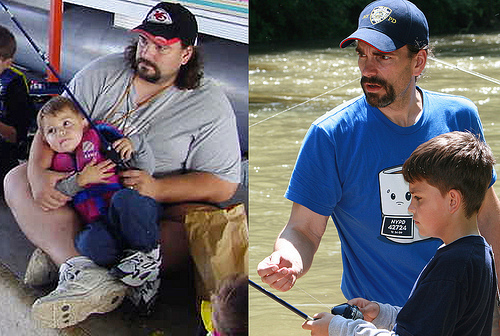
Patrick lost more than 100 pounds on The Slow-Carb Diet.
I find writing very, very difficult.
While on book deadline (right now, for instance), I suffer dramatic ups and downs. In my darkest hours, I re-read reader success stories that have been sent to me. It makes the entire rollercoaster worth it.
This post will detail how readers have lost well over 100 pounds on The Slow-Carb Diet®. It was sparked by an email I received a few weeks ago:
“I just wanted to sincerely thank Tim for taking the time to research and write The 4-Hour Body. My mom, in her late 60′s, lost 45 lbs and got off her high blood pressure meds that she had been on for 20+ years. She did all this in about 3 months. This means that I get to have her around for a long time.”
Anyone can lose hope, and many people do when trying to lose weight. The Slow-Carb Diet (SCD) works almost beyond belief, and it affects much more than appearance. The basic rules are simple:
Rule #1: Avoid “white” starchy carbohydrates (or those that can be white). This means all bread, pasta, rice, potatoes, and grains. If you have to ask, don’t eat it.
Rule #2: Eat the same few meals over and over again, especially for breakfast and lunch. You already do this; you’re just picking new default meals.
Rule #3: Don’t drink calories. Exception: 1-2 glasses of dry red wine per night is allowed.
Rule #4: Don’t eat fruit. (Fructose –> glycerol phosphate –> more bodyfat, more or less.) Avocado and tomatoes are excepted.
Rule #5: Take one day off per week and go nuts. I choose and recommend Saturday.
Comprehensive step-by-step details, including Q&As and troubleshooting, can be found in The 4-Hour Body, but the above outline is often enough to lose 20 pounds in a month, drop two clothing sizes, or more.
The SCD works for both women and men. Maria Rider (pictured below) is over 40 years of age and a mother. As she put it to me, she’d always been “the heavy mom.” Now she’s seen differently: “I haven’t seen this weight since my college years! I just wish you’d written the book 20 years ago!”
Last we spoke, she had dropped from 247 pounds to 122 pounds, for a loss thus far of 125 pounds. Her husband has also lost 56 pounds.

The SCD is also effective for going from “normal” to very, very fit, as MP shows:

MP before.

MP after.
The same exact rules apply. No differences whatsoever.
—-
Next, we’ll meet Ricardo A, in depth. Ricardo first reached out to me via email. It began with…
I cannot put into words the great gift you have given me. “[The Slow-Carb Diet is]…intended to be effective, not fun.” As soon as I read those words, I knew I had to give the slow carb diet a try. 210 days later, I haven’t looked back. The change has been incredible. Not just my weight, but my outlook on life. I have followed your instructions to the letter…”
Below, in Ricardo’s own words, is what happens when you follow SCD to the letter.
Ricardo’s Story
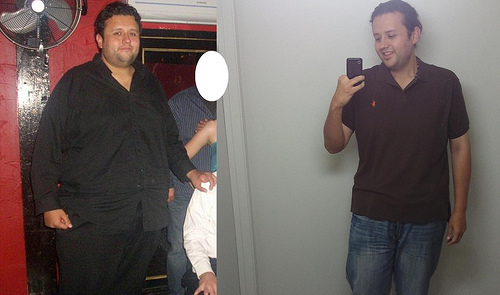
AN INTRODUCTION
People always ask me what moment led me to lose over 150 pounds in 9 months on the Slow Carb Diet (SCD).
I crack a smile when I get asked. Unlike some, who can pinpoint one moment in time which defined the start of their journey, I have three “moments” that immediately come to mind.
The first was months before I started the SCD in August of 2011. It was when I realized that overweight people on TV, told they would die because of their weight, weighed less than I did.
The second moment was the day I got my gym membership card. Instead of it prominently featuring my face, my whole midsection was featured, slumping over the chair.
The third moment, which happened just days before I began the SCD, was when a good friend told me that in order to effectuate positive change in your life, you need strength and guidance. You can acquire strength with discipline and will power, but guidance, well, that’s where Tim comes in.
I recall reading headlines in August that Amazon had just signed its first author for a new publishing arm. Not knowing who Tim Ferriss was, I did some research and found a Gizmodo article. I was at the grocery store that day with my shopping list and began the SCD the very next morning. During my first few days, I was pleasantly surprised to find content and support readily available online, and how much personal feedback Tim would give via his blog. He not only provided you with a plan, but was right there with you when you had any doubts. Tim provided that little push that got me going.
How far I went then was entirely up to me.
LIFE AND STYLE
“It’s a lifestyle, not a diet.”
This is the best answer I can conjure when asked about my success on the SCD. I truly took Tim’s mantra of keeping it simple to heart. Being able to plan all of my meals ahead of time removes not only stress, but also the guilt associated with eating unhealthy foods. My previous “meal plan” consisted of eating junk food three times a day and constant snacking. Not a day would go by without having dessert, consisting of either a pint of rich ice cream or bag of cookies. Looking back, I can easy understand how I got to 410 pounds.
I have been overweight my entire life.
Whenever I managed to lose weight, I’d gain it all back. I had been open to the idea of dieting for some time but found diets too hard to follow. I would start one, and as soon as I cheated or ate incompliant foods, I would give up. This is why I knew the SCD was something I had to try. How could I pass up losing weight while not only being allowed to “cheat”, but being required to do so for an entire day out of the week?
Months after starting the SCD, I ran into an article in the UK’s Daily Mail explaining the science behind postponing eating, which further reinforced the science behind cheat day on the SCD. This, coupled with the outstanding community aspect (via blogs and personal websites), has led to my success and high compliancy rate (over 90% complaint in the past 9 months). I don’t snack, and I only drink unsweetened iced tea and black coffee. I also drink at least a gallon of water a day.
MEAL PLAN ON THE SCD — WHAT HAS WORKED FOR ME
I eat three meals a day.
- Breakfast, which I have no later than an hour after waking up.
- Lunch, which comes at least 4 hours after breakfast.
- Dinner, which is anywhere from 6-8 hours after lunch.
A typical day would look like this:
Breakfast: 8 ounces of egg whites and one whole jumbo organic egg; black beans (canned and unsalted); and steamed cauliflower.
Lunch: ½ pound of vegetarian fed tri-tip steak from trader joes; black beans (canned and unsalted); and steamed cauliflower.
Dinner: frozen chicken thighs (cooked on boiling water until thawed then fried with olive oil); black beans (canned and unsalted); and steamed cauliflower.
When I don’t have time to cook at home, I either get a chicken bowl from Chipotle (no dairy or corn) or order a carne asada (grilled steak) plate at my local burrito shop, which consists of steak, pinto beans, and a salad (no cheese).
Keeping your meals simple makes failure less likely.
CONCLUSION
Based on my experience on the SCD, the only advice I can give you is to stick with it. Your time is now. Don’t make a big fuss about it, and don’t tell it to the mountain. Keep it on the down-low for the first few weeks. This is a personal journey, and success will entirely depend on you. Tim has given you all the tools; now it’s up to you to put them to work. Keep it simple, and if you have to ask, don’t eat it. Save it for your cheat day.
I started the SCD on a Wednesday and did not have my first cheat day until the second Saturday. I invite you to take the “Wednesday Challenge” and do the same. This will give you a head start and allow you to build up will-power.
I still carry the gym membership photo in my wallet every day.

It’s constant motivation to keep at it… to continue on this wonderful, albeit challenging, journey.
I did my part, building the strength through discipline and will power to succeed on the SCD. But without Tim’s guidance, I would not be here telling you my story. Seek strength. Seek guidance.
My name is Ricardo, I am 31-years old, and I’ve lost more than 150 pounds on the SCD. Thank you, Tim.
Afterword from Tim
First of all, thank you, Ricardo. Sincere thanks to all of you who read what I write.
And congratulations to all who’ve made it happen!
Armed with a basic overview of the SCD and a supportive online community (like 4HBTalk), Ricardo lost 150 pounds. Similarly, the others above took a basic plan and put it into practice.
Now, I ask a small favor:
1. If you’re trying to lose fat, commit to testing The Slow-Carb Diet for two weeks starting this Wednesday. Read the above, perhaps consider The 4-Hour Body, and just get started. Put it on the calendar and make it happen.
2. If you’ve lost weight on The Slow-Carb Diet, please fill out the below! It’ll take 10 seconds and help me gather valuable data. Thank you in advance:
Fill out my online form.
(Not showing? Here’s the link.)
3. Last, if you know someone who needs (or wants) to lose weight, please tell them about Slow-Carb somehow.
I don’t care at all if they buy the book or not. The Gizmodo article and other blog links can do a great job. I’ve seen the tremendous difference it can make in the lives of entire families, not just individuals. Whether it’s life-or-death or just looking better in jeans, if you know someone who can benefit, please pass it on.
Thank you for reading, everyone, and have a wonderful week.
If you have any Slow-Carb stories (or before-and-after pics), I’d absolutely love to see them in the comments! They would truly make my summer, which is going to be a tough one…







July 10, 2012
A $50,000 Benevolent Bribe: Is Today The Day You Finally Build Your Business?
Two years ago, Patrick Buckley and Craig Dalton had an idea–an iPad case made using traditional bookbinding. Today, DODOcase is a multi-million dollar business that’s been featured in The New York Times and beyond. They have more than 20 employees, and customers all over the world, including President Barack Obama.
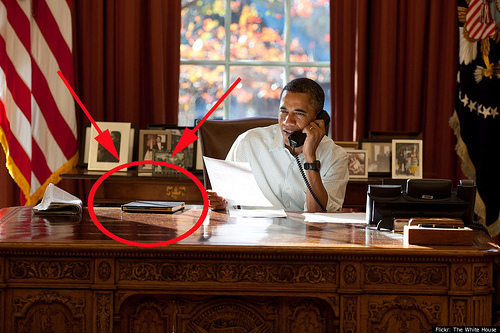
Is that a freaking DODOCase in the Oval Office? Of course it is.
Their rocket-like trajectory started with the 2010 Shopify Build-A-Business Competition. They were the grand-prize winners, but they weren’t the only success story. The stats:
Revenue PER HOUR for the duration of the contest: $696.38
Total number of orders placed: 66,503
Most important — Total businesses created: nearly 1,400
In the subsequent 2011 Shopify competition, more than 3,000 new businesses were launched, generating more than $12,000,000 in revenue. Dave Jackson and Dave Petrillo used Kickstarter to fund their product and went on to win big. Now they’re bringing Coffee Joulies to the mass market on a global scale.
I’ve been involved with the Shopify competition since it was a brainstorm with Tobi, their CEO. Now, it’s your turn to jump in the fray.
This year, I’m joined by three exceptional mentors: Eric Ries (The Lean Startup), Daymond John (FUBU, Shark Tank), and Tina Roth Eisenberg (swissmiss). The education will be better, the community will be bigger, the prizes will be cooler, and the support will be unequaled.
What I said back in 2010 is still true today:
“This competition is intended as a benevolent and encouraging kick in the ass. This stuff isn’t rocket science, but it does require stepping outside your comfort zone for a bit to realize: this isn’t that hard. It’s just unfamiliar. If you do it now, a lot of people will be in the same boat and you’ll take the trip together.”
By turning your idea (that one you’ve reserved for “someday”) into reality, you could win:
- A VIP trip to New York City for a day of meetings with all the mentors
- $20,000 in Google AdWords credit
- A feature on the Fast Company website
- A $50,000 investment in your company from Tim Ferriss, Eric Ries, Daymond John or Tina Roth Eisenberg
If you prefer to take Benjamins and don’t want the involvement from us, that’s cool, too. We’ll give you $50,000 cash. No strings attached, no sweat.
And… even if you don’t win the grand prize:
- You still receive a free .CO domain for 12 months, $100 in Google AdWords Credits, and $100 in MailChimp Credits, just for entering the competition.
- You could end up with the greatest gift of all: a profitable business that becomes your muse.
The latter is the whole point.
Ready to join the ranks, shed a little blood with your brethren (mere papercuts, guys), and fundamentally change your life forever?
If not now, when?
Go here. Get excited. Pull the trigger.
###
Related and Suggested:
Looking for business ideas? Browse some of the detailed case studies in the “Engineering the Muse” posts, digest 17 lessons from six-figure business started for $100 or less, or take a peek at successful examples on Shopify.
Perhaps most helpful of all, here are two posts on lessons learned from past winners: do’s and don’ts from 2010 and 2011.
—-
Odds and Ends:
Wow. Thank you to everyone who shared their personal career struggles and aspirations around risk. Ben Casnocha and Reid Hoffman selected three finalists from over 500 comments — Samuel P.N. Cook, Dennis Keochane, and Cheryl Obermiller — and they’d like to ask YOU to vote on who should win mentorship for their next career move.
Although they sadly cannot offer direct mentorship to everyone, they can offer the next best thing — the mentorship of their network! Repost your story of risk or other thoughts on career strategy as a new discussion in their LinkedIn Group. Their online network has more than 2,000 career experts who are committed to investing in themselves and helping others.
The Council That Kicked The Hornet’s Nest — Why TODAY Matters for Start-Ups

This man hates you and your start-up.
Hi All,
This short post is more like a personal letter, because I just came across something that made me very angry. Namely, a tweet from my bud, Kevin Rose:
Wow, a business (Uber) is prevented from lowering its prices.. wait.. what? We live in America, right?
http://tcrn.ch/NfYOT3
In full disclosure, I’ve been an advisor to Uber from the beginning. They’re amazing. I work with 20+ start-ups because because I enjoy helping entrepreneurs who want to change the world. Small-business founders are the value creators of our economy. Period, end of story.
But sometimes the corrupt (often with a track record) try to stifle the little guys. Incumbents don’t like to compete. They enjoy their defacto monopolies, are accustomed to bilking customers at will, and don’t want to change things.
Pardon my Long Island French, but here’s how I feel: Fuck those guys.
Protecting the status quo doesn’t impress me. In fact, it really pisses me off.
The last time I implored you to spend a few minutes to change laws, we helped successfully ban the distribution and sale of shark fins in Washington and California, the latter being the largest importer of shark fins in the United States.
YOUR TINY ACTIONS, PUT TOGETHER, CAN MOVE MOUNTAINS.
Below is a snapshot of the Uber situation from the TechCrunch article, and I have a little ask at the end. It’ll get you some good karma:
The Council’s intention is to prevent Uber from being a viable alternative to taxis by enacting a price floor to set Uber’s minimum fare at today’s rates and no less than 5 times a taxi’s minimum fare. Consequently they are handicapping a reliable, high-quality transportation alternative so that Uber cannot offer a high quality service at the best possible price. It was hard for us to believe that an elected body would choose to keep prices of a transportation service artificially high – but the goal is essentially to protect a taxi industry that has significant experience in influencing local politicians. They want to make sure there is no viable alternative to a taxi in Washington DC, and so on Tuesday [today!], the DC City Council is going to formalize that principle into law.
…
Take Action
THE COUNCIL VOTES ON THE UBER AMENDMENT [TODAY]!
If each of us writes or calls our DC Council people, we could make an impact on this law. What are we asking for?
Strike down the MINIMUM FARE language from the Uber Amendment.
Here are the City Council members’ contact info. Call/write as many of them as possible!
Phil Mendelson (Chairman), (202) 724-8064, [email protected]
Mary Cheh, Ward 3, (Chairperson of Committee on the Environment, Public Works and Transportation), (202) 724-8062, [email protected], @marycheh
Michael Brown, at-large, (202) 724-8105, [email protected], @cmmichaelabrown
Jim Graham, Ward 1, (202) 724-8181, [email protected], @jimgrahamward1
Jack Evans, Ward 2, (202) 724-8058, [email protected], @jackevansward2
Muriel Bowser, Ward 4, (202) 724-8052, [email protected], @murielbowser
Kenyan McDuffie, Ward 5, (202) 724-8028, [email protected],@kenyanmcduffie
Tommy Wells, Ward 6, (202) 724-8072, [email protected], @tommywells
Yvette Alexander, Ward 7, (202) 724-8068, [email protected], @cmyma
Marion Barry, Ward 8, (202) 724-8045, [email protected], @marionbarryjr
David Catania, at-large, (202) 724-7772, [email protected], @cataniapress
Vincent Orange, at-large, (202) 724-8174, [email protected], @vincentorangedc
Those of you who read this blog know that I never write posts like this.
But I take this attack on Uber as a DC government-condoned attack on start-ups. I view it as an entrenched middle finger from incumbents who aren’t willing to improve their product or lower prices. Instead, they resort to underhanded legal means to handicap innovation. It makes my blood boil.
So, here’s what I’m going to do.
1) I’m going to e-mail every one of the above people today and tell them to read this post. E-mail helps, but phone is better…
2) Personally, I’m going to call every one of them today and politely but firmly ask them to “strike down the MINIMUM FARE language from the Uber Amendment.” I will have my assistants do the same. This shouldn’t take more than 20 minutes or so, but I won’t ask that of you…
3) I’m going to ask you all — the 1,000,000+ unique readers of this blog — to call as many of the above as possible. Let’s aim for the first four. But there’s more… Politely but firmly, get the name of the person you’re speaking with, tell them you’d like them to “strike down the MINIMUM FARE language from the Uber Amendment” and then ask them if they’re in favor of innovation or incumbents. Last, indicate that you’ll be putting their responses in the comments below.
—
This DC attack could set a horrible precedent for start-ups trying to improve any space with large incumbents. If you have a few minutes, please make one phone call. It will earn you positive karma… and the knowledge that you didn’t stand still and watch Goliath snuff out David with his thumb. There’s something real to be said for that.
Sorry for the rant, but this one is legitimate. To my mind, it cannot go unanswered.
Please spread the call to action far and wide. This is time-sensitive and needs to happen ASAP today.




















